The China Minimally Invasive Cardiovascular Surgery Conference 2022 and China Minimally Invasive Cardiac Surgery Live Surgery Week 2022 (CMC Week 2022), which will be held from October 24 to November 4, 2022, is in full swing.
On November 2, Professor Jidong Liu of the Department of Cardiovascular Surgery at Renji Hospital, Shanghai Jiao Tong University School of Medicine, presented a live endoluminal procedure for left subclavian artery reconstruction using the J.D method with the use of the Syngenta Ankura™ II stent combined with the Syngenta Futhrough™ Aortic Coated Stent Breaking System in an in-situ open window at the arch.
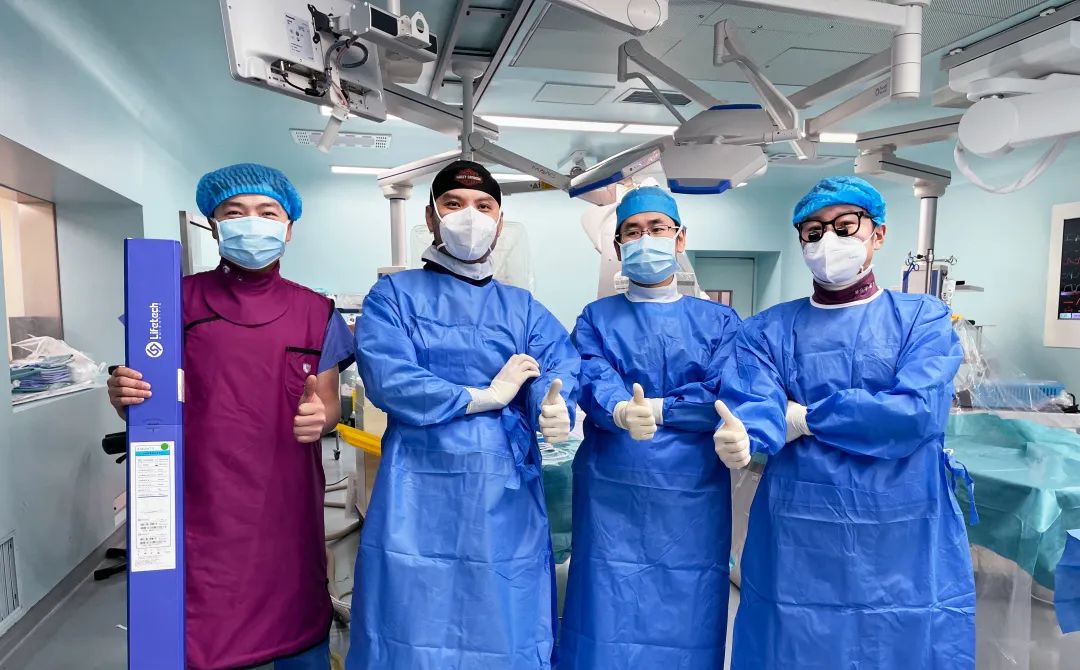
Prof. Jidong Liu
Case Information
A 74-year-old woman was admitted 10 days ago with "sudden severe chest and back pain for more than 6 hours" and was referred to an outside hospital for "Stanford type B aortic coarctation".
He had a long history of poorly controlled hypertension (sNBP=150-180mmHg). He had been taking oral NSAIDs for nearly 20 years for rheumatoid arthritis.
After being admitted to the hospital, he was treated with routine sedation and analgesia, pressure control, heart rate control, etc., and his chest pain was significantly relieved. His blood pressure was under good control (sNBP=120-140mmHg), and he had no signs of ischemia in any organ or limb. Blood biochemistry examination was not special.
Preoperative CTA findings
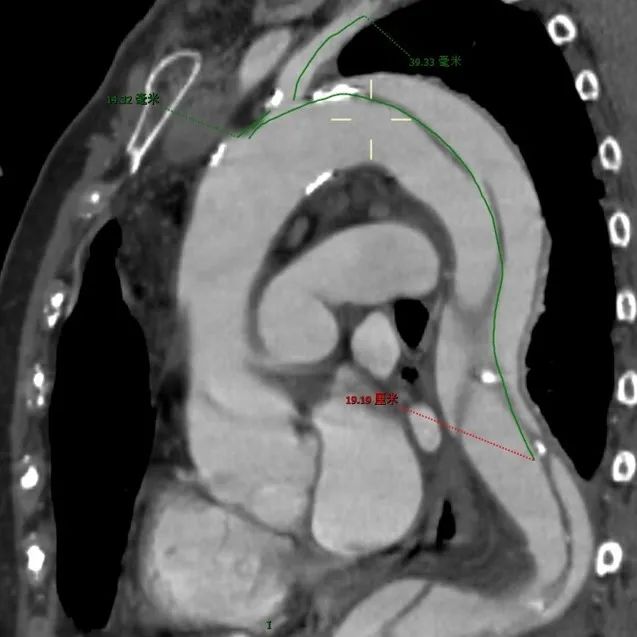
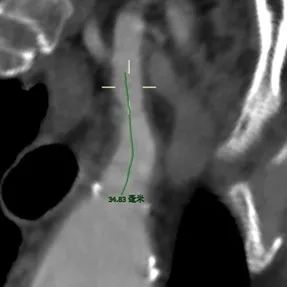
Stanford type B acute aortic coarctation
■ The breach is located lateral to the greater curvature, with anterior involvement of the posterior margin of the LSA
■ LSA-LCCA pitch 14.3mm
■ Distance from left vertebral artery opening to LSA opening: 34.8mm
■ All true lumen except right renal artery entrapment torn in
■ Extremely small true lumen at subrenal level
■ Severe aortic calcification
■ Severe distortion of the aorta near the level of the diaphragm
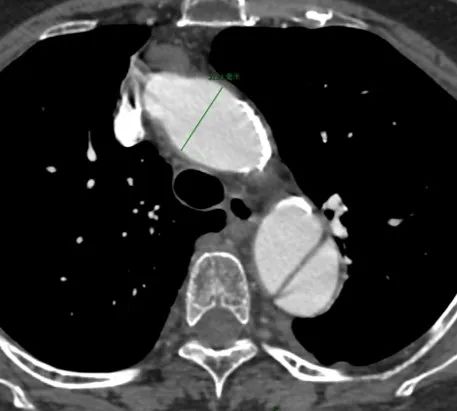
Proximal
Cross-section diameter 31.7mm
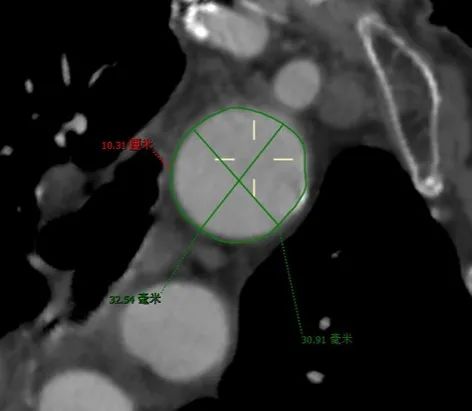
Proximal
MPR Section Reconstruction
Diameter 30.9-32.5mm
Perimeter Extrapolation Diameter 32.8mm
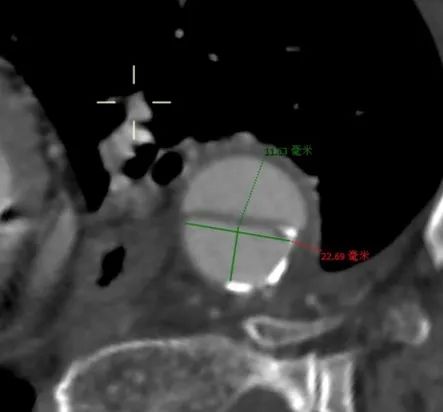
Remotely
True cavity: 11.6*22.7mm
Surgical program
■ JD method of reconstructing LSA
■ Main Bracket: Sage Ankura™ II: 32-24-200
■ Branch bracket: FVL 10*40mm self-expanding laminating bracket reconstruction LSA
■ Projection angle: LAO42°
■ Access: total right femur
Surgical procedure
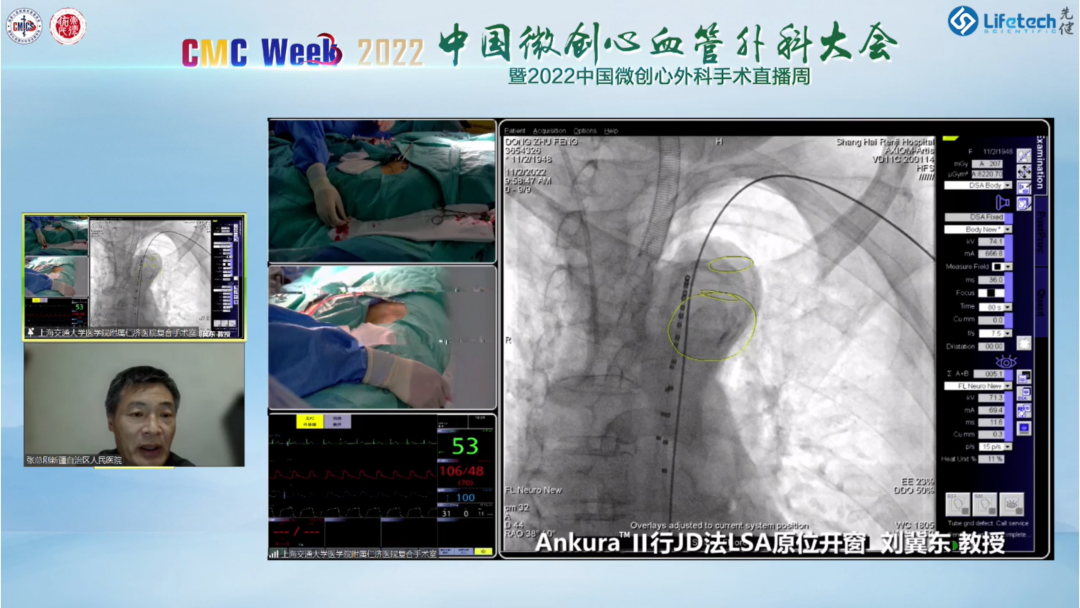
The right femoral artery was punctured under fluoroscopy to confirm that the puncture site was in a good position in the common femoral artery, and a 16Fr vascular sheath was left in place to introduce a pigtail guidewire and a loach guidewire, and the guidewire was placed in the true lumen of the aorta via the true lumen through the lowering of the aorta.
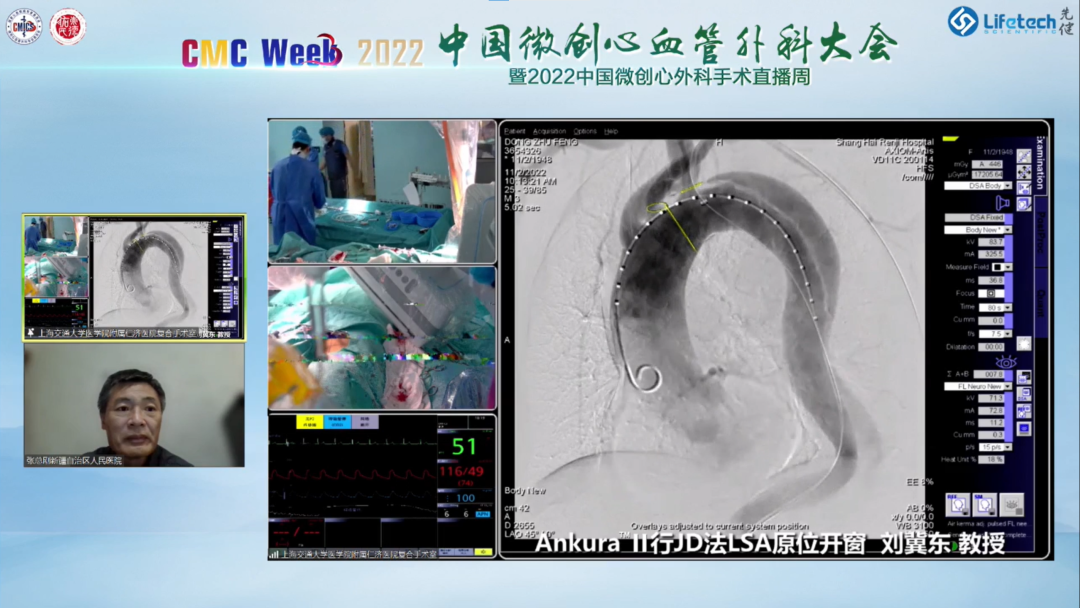
The left brachial artery was incised and dissected layer by layer to expose the left brachial artery, and a 9Fr sheath was punctured at the opening of the left subclavian artery near the aortic segment. A 4F-MPA catheter with a built-in controllable guidewire was placed through the anterior wall of the aorta and left distal to the true lumen of the descending aorta to serve as a retractor guidewire.
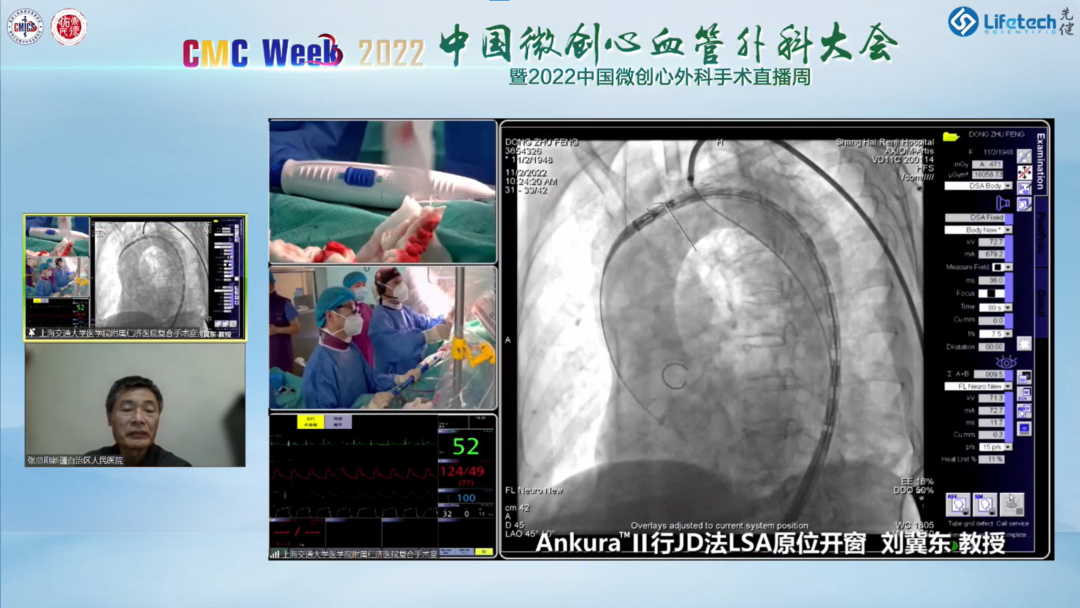
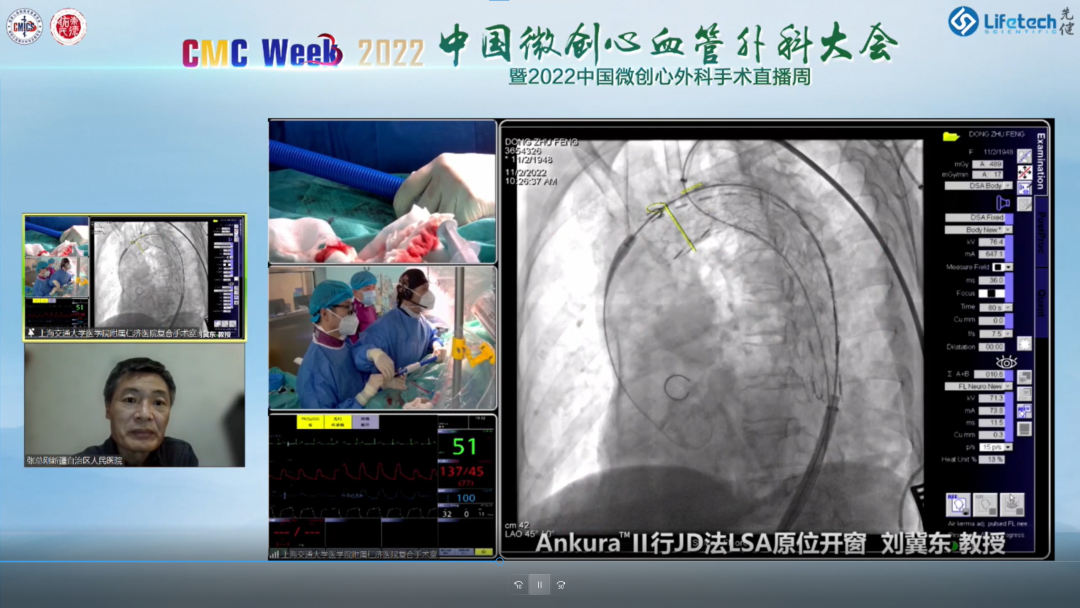
A guidewire is placed in the ascending aorta through the femoral sheath, the sheath and catheter are removed, and the CK Ankura™ II Aortic Coated Stent System is introduced and released under fluoroscopy. The proximal laminating segment started at the posterior border of the left common carotid artery and fully covered the left subclavian artery.
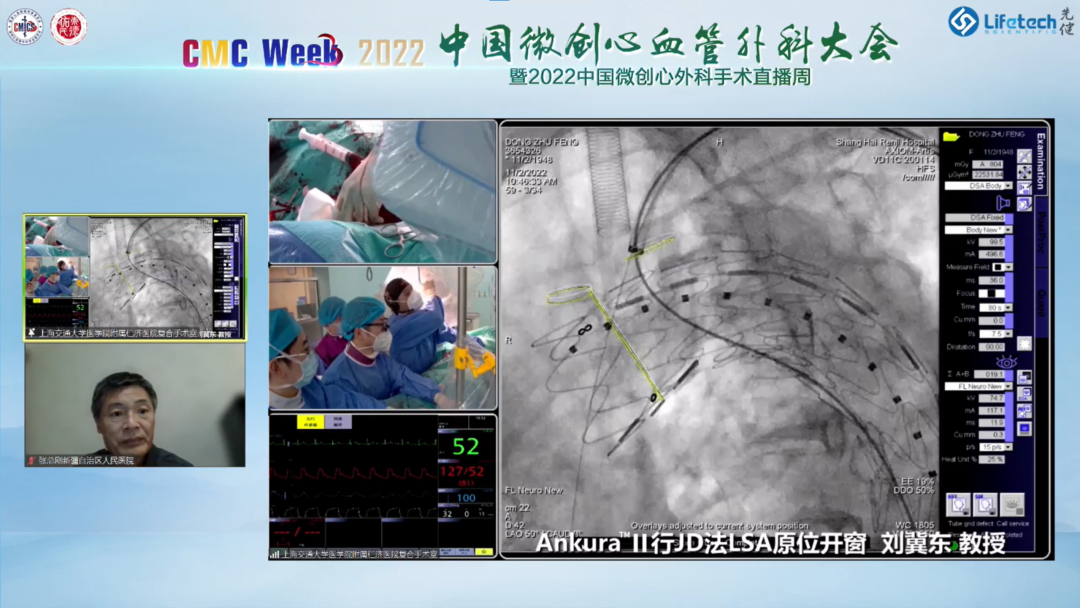
Through the 9Fr sheath of the left brachial artery, the Sage Futhrough™ Aortic Coated Stent Breaking System was introduced, and the main stent coated with the stent was punctured at the opening of the left subclavian artery to break the membrane and dilated with a balloon, and then a vascular branching stent was introduced to reconstruct the left subclavian artery, and dilated with a balloon.
Surgical results
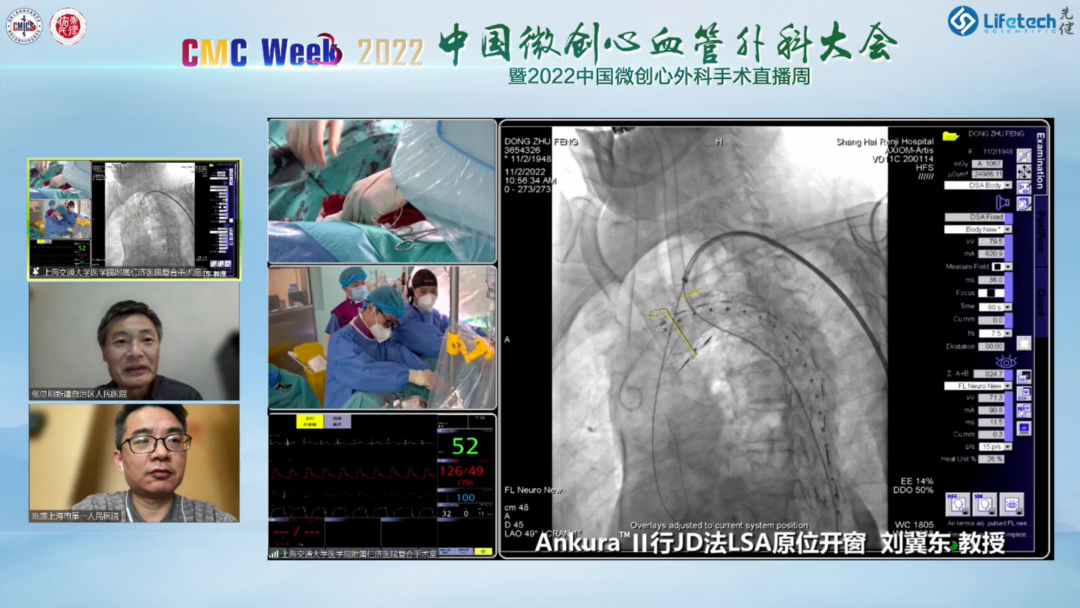
Postoperative imaging showed good stent deployment pattern, no internal leakage of branching stents, and satisfactory tumor isolation.
The procedure adopts the J.D. method of opening the window in situ, i.e., forming an "anterior junction" with the pigtail catheter, and utilizing a traction system that allows the sheath to go through the anterior wall of the aorta toward the distal descending aorta (Descending). This compensates for the displacement of the puncture system as it passes through the sheath and minimizes the possibility of LSA damage from the sheath.
Prof. Jidong Liu demonstrated in full detail the use of the CIH Ankura™ II stent in combination with the CIH Futhrough™ Aortic Coated Stent Membrane Breaking System for endoluminal reconstruction of the left subclavian artery by in situ opening of the arch, which is a unique advantage of the CIH Ankura™ II stent with a double-layer e-PTFE membrane material that makes the stent more suitable for in situ windowing. Together with the Futhrough™ Aortic Overlay System, the Ankura™ II stent has the unique advantage of adapting to the different anatomical configurations of the left subclavian artery, providing an innovative solution for the treatment of complex thoracic aortic arch lesions.
Introduction to the discipline
The Department of Cardiovascular Surgery at Renji Hospital, Shanghai Jiao Tong University School of Medicine was founded by Prof. Liang Qichen and Prof. Wang Yishan, the famous cardiothoracic surgeons in China, and is one of the earliest to carry out cardiac surgery and one of the earliest to grant master's degree and doctor's degree in China.In 1954, Prof. Lan Xichun carried out China's first case of mitral valve closed detachment surgery in the hospital, which initiated the precedent of cardiac surgery in China.
The current director of the department, Prof. Xue Song, is a PhD student and postdoctoral supervisor. Under the leadership of Prof. Song Xue, the department has become one of the hospital's centers with remarkable professional characteristics and high reputation in the discipline, and has been ranked in the forefront of cardiovascular surgery in China for three consecutive years in China's Hospital Science and Technology Measurement (STEM).
As a large macrovascular surgery center in East China, the department has gradually explored and established a whole set of clinical diagnosis and treatment modes and processes under the initiative of Director Xue Song, opened a 24-hour emergency green channel for patients, and constructed an aortic coarctation rescue and treatment life circle in East China. The department routinely carries out surgery for thoracic aortic aneurysm and acute aortic coarctation aneurysm, and the surgical modalities include aortic root reconstruction (David, Bentall's), aortic arch replacement, total thoracic and abdominal aortic replacement, and other difficult surgeries, and the difficulty of surgeries carried out and the quality of surgeries carried out are at the forefront of the national level. Prof. Xue Song was the first in Shanghai and the first in China to apply intraoperative triple bifurcation stenting for the treatment of acute type I aortic coarctation aneurysm, and the first in China to apply stent implantation and surgical hybridization techniques for the treatment of aortic diseases. The department has basically realized "no diagnosis and treatment blind area" and "no technical short board", and is steadily progressing towards the goal of building a top domestic and international cardiovascular surgery center.
In terms of scientific research, the department has undertaken 7 projects of the National Natural Science Foundation of China in the past five years and 19 projects at provincial and ministerial levels, with a total project fund of more than 5 million yuan, and has published more than 50 SCI articles.
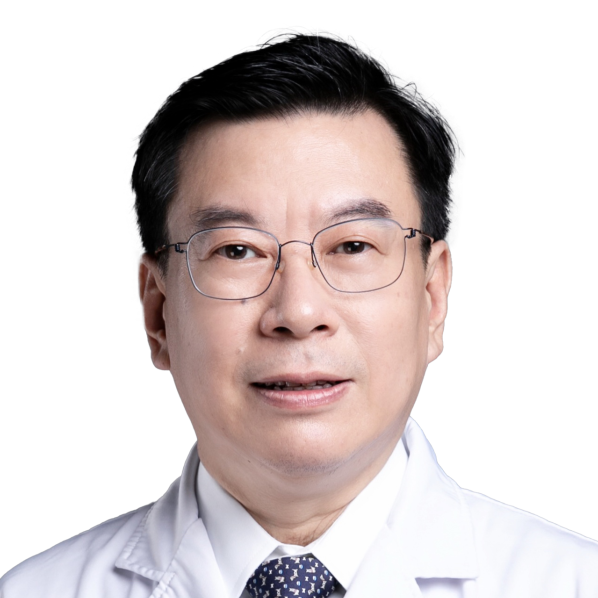
Prof. Song Xue
Renji Hospital, Shanghai Jiao Tong University School of Medicine
M.D., Professor, Chief Physician, Ph.
Director of Cardiovascular Surgery, Renji Hospital, Shanghai Jiao Tong University School of Medicine, Shanghai, China
● National member of the Thoracic and Cardiovascular Surgery Branch of the Chinese Medical Association
● Chairman-designate of the Cardiovascular Surgery Society of Shanghai Medical Association
● Vice Chairman of the Cardiovascular Surgery Branch of Shanghai Municipal Physicians Association
● Vice Chairman of Minimally Invasive Cardiovascular Surgery Branch of National Cardiovascular Disease Center Expert Committee
● Member of the International Society of Minimally Invasive Cardiothoracic Surgery
● Member, Asia-Pacific Society for Thoracic Surgery
● Member of the Asia-Pacific Society for Thoracic Surgery
● Member of the Cardiovascular Surgery Branch of the Chinese Physicians Association
● Member, National Cardiovascular Disease Center Expert Committee, Vascular Surgery Specialty Committee
● Vice Chairman of Cardiac Regeneration Group of Chinese Medical Association Tissue Repair and Regeneration Branch
● Vice Chairman, Cardiovascular Surgery Group, Taiwan-Hainan Medical Development Committee, Cross-Strait Medical and Health Exchange Association
● Standing Committee Member of the Academic Committee of Heart Valve Disease Intervention Technology, Asian Association of Heart Valve Disease (AAHVD) China Chapter
● Member of the Cardiovascular Section of the Chinese National Health Association (CNHA)
● Honored as one of the "Top Ten Doctors" in Shanghai.
He has extensive experience in the field of coronary heart disease, large vessel disease, heart valve disease, congenital heart disease and surgical treatment of cardiac arrhythmia. He specializes in non-stop coronary artery bypass grafting surgery, aortic coarctation and aortic aneurysm surgery, minimally invasive heart valve surgery with thoracoscopic assistance, complex congenital heart disease surgery and transcatheter aortic valve replacement. In Shanghai, we are the first to successfully perform "minimally invasive multi-vessel coronary artery bypass grafting with small incision", "four-valve heart replacement + giant ventricular septal defect repair", "triple bifurcation stenting of the aortic arch for the treatment of aortic coarctation", "aortic coarctation and aortic aneurysm", and "aortic coarctation and aortic aneurysm". ", "double valve replacement under needle anesthesia", "non-stop coronary artery bypass grafting under needle anesthesia", as well as a variety of minimally invasive cardiovascular surgery with small incisions and other new technologies. In China, he was the first to carry out interventional therapy for various cardiovascular diseases. He was awarded the Second Prize of Shanghai Medical Science and Technology Progress in 2021. He is an editorial board member of Chinese Journal of Thoracic and Cardiovascular Surgery, Innovations, Chinese Journal of Experimental Surgery, Chinese Abstracts of Surgery, International Journal of Cardiovascular Disease, Chinese Journal of Cardiovascular Disease, etc. He is also an expert of Chinese Journal of Medical Sciences, and has published more than 100 papers in domestic and international core journals and more than 50 papers have been indexed in SCI. He has published more than 100 papers in core professional journals at home and abroad, and more than 50 papers in SCI;
Associate editor of the planned textbook "Surgery" of the Higher Education Press, and participated in the preparation of monographs such as "Lan Xijun Cardiovascular Surgery", "Cardiovascular Anesthesiology", "Adult Cardiac Surgery", and so on.
As a project leader, he has undertaken a number of national and provincial projects, including the National Natural Science Foundation of China, sub-projects of the National 973 Project, the National Science and Technology Support Program, key projects of the Shanghai Municipal Science and Technology Commission, key projects of the Shanghai Municipal Bureau of Health, key projects of the Pudong New Area, and international cooperation projects. His main research interests include basic and clinical research on coronary heart disease and aortic coarctation. He has won the China Medical Science and Technology Award, Shanghai Science and Technology Progress Award, Shanghai Medical Science and Technology Progress Award and other awards.
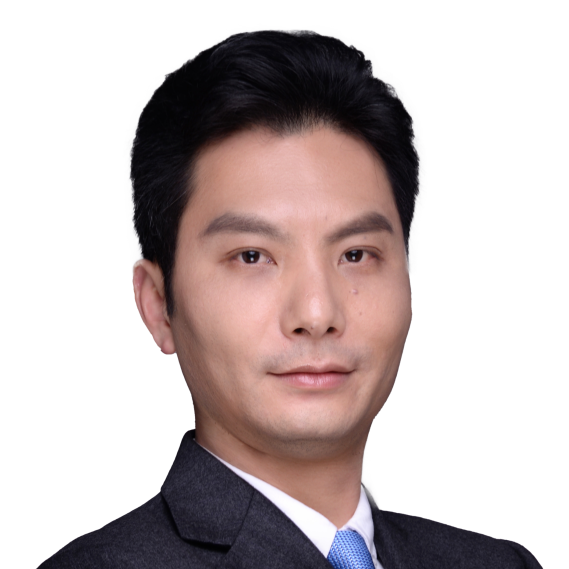
Prof. Jidong Liu
Renji Hospital, Shanghai Jiao Tong University School of Medicine
Associate Chief Physician, Department of Cardiovascular Surgery, Renji Hospital, Shanghai Jiao Tong University School of Medicine, Shanghai, China. He received special training in Transcatheter Aortic Valve Replacement (TAVR) in France from 2013 to 2014, and went to Canada in 2016 to receive special training in teaching clinical medicine. He is currently an adjunct professor at the Shanghai Jiao Tong University - University of Ottawa Joint School of Medicine, and an expert of the Surgical Intervention Expert Working Group of the Expert Committee of the National Cardiovascular Disease Specialty Quality Control Center.
As a new generation of composite cardiovascular surgeon, he not only masters the classic extracorporeal circulation direct visualization cardiac surgery, but also takes transcatheter minimally invasive interventional therapy as the technical characteristics: independently completes coronary angiography; independently completes the interventional therapy of congenital heart disease; independently completes the whole lumen stent repair and branch reconstruction of complex macrovascular disease, and owns the original in situ windowing technique of left subclavian artery-JD method; Hybrid composite aortic surgery; and independently completes the various pathways of the transcatheter aortic valve replacement (TAVR).


